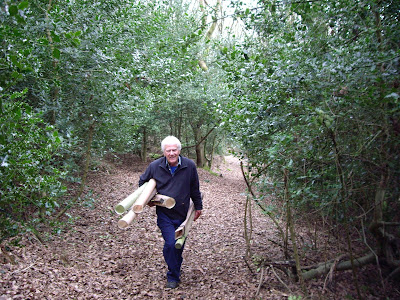The target species for the survey are:
- Grey wagtail, Dipper and Kingfisher
- Black darter, Azure Damselfly and Golden ringed dragonfly
- Water voles and otters
- Japanese knotweed, Himalayan balsam, Giant hogweed and Australian swamp stonecrop, all invasive species.
The day began inside......
After looking at illustrations of the different species and
hearing a description of what to look for – tracks, droppings, evidence of
feeding etc, we set off to Fishponds Wood, via False Tooth Bridge, examining the
stream and pond edges for mammal signs and watching for dippers, kingfishers and grey wagtails, all of which have been
seen here. There was little expectation of seeing the invasive plants or
invertebrates this early in the year but one dipper was noted, and one small
example of Himalayan balsam, greeted with delight by the volunteers.
Julia! Mind the troll, fol-dee-rol.
He's going to eat you, for his dinner.
Come out, come out, wherever you are.
Our hope
of finding otter spraint wasn’t successful but we were geared up to recognise
it, having been given the delightful experience of smelling a sample during the
indoor training. Not a fragrance that anyone is likely to forget.
We headed back to the Council Chamber for lunch – the
forecast of cold weather sweeping in was accurate – and Audrey’s flapjacks were
a welcome addition to the meal.
Warm and cosy at lunchtime.
The target area for the afternoon was Fountains Abbey. Dry
most of the time but with some heavy hail showers from which we had to take
shelter. Searching here was more productive. One grey wagtail, two dipper nests
and a dipper flying were all found but sadly no mammal evidence.
Key points for examination were tunnels (everyone who went in, came out).
Also the under sides of bridges, and features in and around the streams,
particularly rocks that might show spraint, and holes in the banks.
This is a dipper's nest.
We ended the day with a good understanding of the species to
search for and the recording that’s necessary. We also have maps of the two
areas visited with transect lines to show the routes to follow while involved
in the Wild Watch.
Any help with the surveys by NCVs will be very much
appreciated - once again, citizen science in action.
Thanks to Jennie and Alice for an enjoyable and very
interesting day (and of course to Audrey for the flapjacks).
Tony




















































